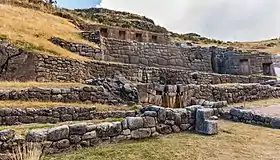 View of Tambomachay. | |
 Shown within Peru | |
| Location | Cusco District, Cusco |
|---|---|
| Type | Fortress |
| History | |
| Periods | Late Horizon |
| Cultures | Inca |
Tambomachay[1] (possibly from Quechua tampu inn, guest house, mach'ay cave, or machay drunkenness, to get drunk or "spindle with thread")[2][3] is an archaeological site associated with the Inca Empire, located near Cusco, Peru. An alternate Spanish name is El Baño del Inca ("the bath of the Inca").
It consists of a series of aqueducts, canals and waterfalls that run through the terraced rocks. It is situated near springs such as the one called Timpuc Puquiu, a boiling spring on the northern bank of the Timpuc River and the spring near Huaylla Cocha community.[4] These natural springs were channeled through three waterfalls that still flow today.[5]
The function of the site is uncertain: it may have served as a military outpost guarding the approaches to Cusco, as a spa resort for the Incan political elite[6] or imperial baths.[7] It could have also served a religious function[8] since sacred water fountains were found almost all of major Incan temple such as Pisac, Ollantaytambo, and Machu Picchu. There are sources that refer to Tambomachay as one of the nine ceques built along the Road of Antisuyu, describing it as an Incan house where sacrifices were also made.[9]
.jpg.webp)
 Three small baths at Tambomachay
Three small baths at Tambomachay Ancient ruins
Ancient ruins Upper view
Upper view





References
- ↑ "GRUPO ARQUEOLÓGICO DE TAMBOMACHAY". MINCETUR. Retrieved 2017-05-29.
- ↑ Teofilo Laime Ajacopa (2007). Diccionario Bilingüe: Iskay simipi yuyayk’anch: Quechua – Castellano / Castellano – Quechua (PDF). La Paz, Bolivia.
{{cite book}}: CS1 maint: location missing publisher (link) - ↑ Diccionario Quechua - Español - Quechua, Academía Mayor de la Lengua Quechua, Gobierno Regional Cusco, Cusco 2005 (Quechua-Spanish dictionary)
- ↑ Bauer, Brian S. (2010). The Sacred Landscape of the Inca: The Cusco Ceque System. Austin: University of Texas Press. p. 76. ISBN 978-0-292-70865-5.
- ↑ Dubé, Ryan (2016-11-01). Moon Machu Picchu: Including Cusco & the Inca Trail. Avalon Publishing. ISBN 978-1-63121-386-1.
- ↑ Kaufmann, H. W. & J. E (2006). Fortifications of the Incas: 1200-1531. Osprey Publishing. p. 37. ISBN 1-84176-939-8.
- ↑ Jenkins, Dilwyn; Deere, Kiki (2015-10-01). The Rough Guide to Peru, Ninth Edition. Rough Guides UK. p. 231. ISBN 978-0-241-24675-7.
- ↑ Kaufmann, H. W.; Kaufmann, J. E. (2012). Fortifications of the Incas: 1200–1531. Oxford: Osprey Publishing. p. 37. ISBN 978-1-84908-046-0.
- ↑ Cobo, Bernabe (2004). Inca Religion and Customs. Austin: University of Texas Press. p. 63. ISBN 0-292-73861-7.
External links
13°28′51″S 71°57′53″W / 13.48083°S 71.96472°W